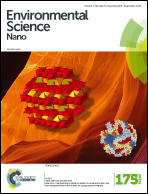Spectroscopic and theoretical studies on the counterion effect of Cu(ii) ion and graphene oxide interaction with titanium dioxide†
Abstract
With the widespread use of graphene oxide (GO), it is inevitable that part of GO is released into the environment and co-exist with heavy metal ions as contaminants and is likely to be co-adsorbed on minerals and oxides. This study, for the first time, demonstrates the individual and mutual removal mechanism of GO and Cu(II) on titanium dioxide (TiO2) by batch experiments, spectroscopic analysis and density functional theory (DFT) computations. Electrostatic interaction and hydrogen bonding are the dominant modes of GO sorption onto TiO2, and the interaction of Cu(II) with TiO2 is mainly dominated by inner-sphere surface complexation. The presence of Cu(II) enhances GO coagulation on TiO2 and vice versa. The experimental results are further verified by DFT sorption energy (Es) calculations in the order (TiO2–GO)–Cu > TiO2–GO for GO interaction and (TiO2–GO)–Cu > TiO2–Cu for Cu(II) interaction. The mutual interaction is favorable for the simultaneous removal of GO and heavy metal ions by surface complexation between Cu(II) and oxygen-containing functional groups. These findings might facilitate better understanding of the co-removal behavior of carbon nanomaterials and heavy metal ions on oxides, which is crucial to decreasing the environmental toxicity of pollutants in the natural environment.



 Please wait while we load your content...
Please wait while we load your content...